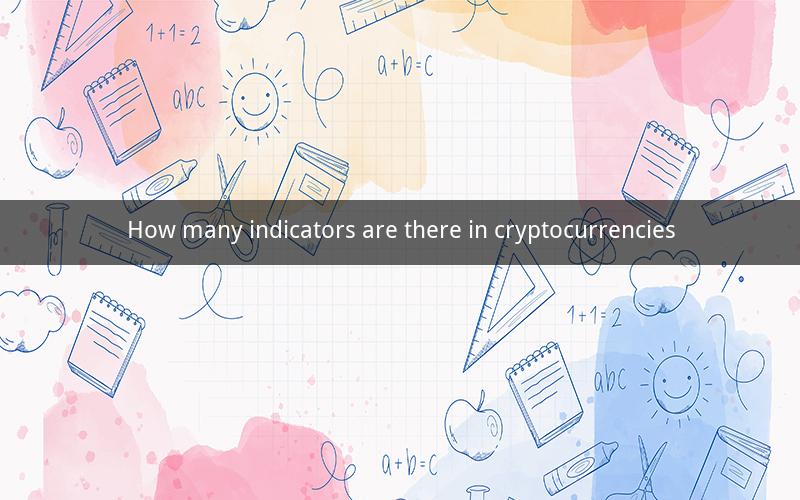
Directory
1. Introduction to Cryptocurrency Indicators
2. Types of Cryptocurrency Indicators
3. Common Cryptocurrency Indicators
4. Importance of Indicators in Cryptocurrency Trading
5. How to Use Cryptocurrency Indicators Effectively
6. Limitations of Cryptocurrency Indicators
7. Future Trends in Cryptocurrency Indicators
8. Conclusion
1. Introduction to Cryptocurrency Indicators
Cryptocurrency indicators are tools that help traders and investors analyze the market and make informed decisions. These indicators are used to assess the potential price movements of cryptocurrencies and provide insights into market trends. In this article, we will explore the various indicators available in the cryptocurrency market and their importance in trading.
2. Types of Cryptocurrency Indicators
There are two main types of cryptocurrency indicators: technical indicators and fundamental indicators.
Technical Indicators
Technical indicators are based on historical data and are used to analyze past price movements and predict future trends. These indicators are commonly used in technical analysis, which involves studying past market data to predict future price movements.
Fundamental Indicators
Fundamental indicators are based on economic, social, and political factors that can affect the value of cryptocurrencies. These indicators help traders and investors assess the intrinsic value of a cryptocurrency and make informed decisions.
3. Common Cryptocurrency Indicators
Moving Averages
Moving averages are one of the most popular technical indicators used in cryptocurrency trading. They calculate the average price of a cryptocurrency over a specified period of time, which can help traders identify trends and potential entry and exit points.
Relative Strength Index (RSI)
The RSI is a momentum oscillator that measures the speed and change of price movements. It ranges from 0 to 100 and is used to identify overbought or oversold conditions in the market.
Bollinger Bands
Bollinger Bands consist of a middle band, which is an average price of a cryptocurrency, and two outer bands that represent the standard deviation from the average. These bands can help traders identify potential price levels and trend reversals.
Fibonacci Retracement
Fibonacci retracement is a tool used to identify potential support and resistance levels based on historical price movements. Traders use Fibonacci retracement levels to enter and exit trades.
4. Importance of Indicators in Cryptocurrency Trading
Indicators play a crucial role in cryptocurrency trading for several reasons:
- Identifying Trends: Indicators help traders and investors identify the current trend in the market, whether it's upward, downward, or sideways.
- Predicting Price Movements: By analyzing historical data, indicators can provide insights into potential price movements in the future.
- Making Informed Decisions: Indicators can help traders make informed decisions by providing objective data that can be used to assess the market.
5. How to Use Cryptocurrency Indicators Effectively
To use cryptocurrency indicators effectively, traders should:
- Understand the Indicators: It's important to have a thorough understanding of each indicator and how it works.
- Combine Indicators: Combining multiple indicators can provide a more comprehensive view of the market.
- Set Realistic Goals: Set realistic goals based on the indicators' signals and be prepared to adjust strategies as needed.
6. Limitations of Cryptocurrency Indicators
While cryptocurrency indicators can be useful tools, they also have limitations:
- Market Volatility: Cryptocurrency markets are highly volatile, which can make indicators less reliable.
- Lack of Standardization: There is no standard set of indicators for the cryptocurrency market, which can lead to inconsistencies.
- Overreliance: Overreliance on indicators can lead to poor decision-making and increased risk.
7. Future Trends in Cryptocurrency Indicators
As the cryptocurrency market continues to evolve, we can expect to see several future trends in cryptocurrency indicators:
- More Advanced Algorithms: As technology advances, we can expect to see more advanced algorithms and indicators that provide more accurate predictions.
- Integration with Other Technologies: Cryptocurrency indicators may be integrated with other technologies, such as artificial intelligence and machine learning, to provide even better insights.
- Greater Standardization: There may be greater standardization in the cryptocurrency market, leading to more consistent and reliable indicators.
8. Conclusion
Cryptocurrency indicators are essential tools for traders and investors looking to navigate the complex and highly volatile cryptocurrency market. By understanding the different types of indicators and how to use them effectively, traders can improve their chances of making successful trades. However, it's important to be aware of the limitations of indicators and not to overrely on them when making trading decisions.
Questions and Answers
1. What are cryptocurrency indicators?
Cryptocurrency indicators are tools used to analyze the market and predict future price movements.
2. What are the two main types of cryptocurrency indicators?
The two main types of cryptocurrency indicators are technical indicators and fundamental indicators.
3. What is the purpose of moving averages in cryptocurrency trading?
Moving averages are used to identify trends and potential entry and exit points in the market.
4. How does the RSI help traders?
The RSI helps traders identify overbought or oversold conditions in the market.
5. What are Bollinger Bands used for?
Bollinger Bands help traders identify potential price levels and trend reversals.
6. How can Fibonacci retracement be used in trading?
Fibonacci retracement can be used to identify potential support and resistance levels.
7. Why are indicators important in cryptocurrency trading?
Indicators help traders identify trends, predict price movements, and make informed decisions.
8. How should traders use indicators effectively?
Traders should understand the indicators, combine them, and set realistic goals.
9. What are the limitations of cryptocurrency indicators?
Limitations include market volatility, lack of standardization, and overreliance on indicators.
10. What future trends can we expect in cryptocurrency indicators?
Future trends include more advanced algorithms, integration with other technologies, and greater standardization.